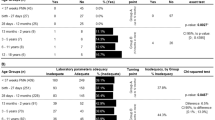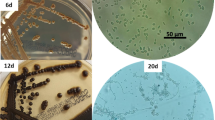Summary
Systemic fungal infection occurs in 2 to 4.5% of very low birth-weight (VLBW) infants (<1,500 g) and may be fatal in 25 to 54%.Candida sp. is the major pathogen and amphotericin B the treatment of choice. To reduce side effects and optimize drug action, a formulation of amphotericin B encapsulated in liposomes (AmBisome®) has been introduced. Data on 21 VLBW infants who received a full course of AmBisome® was collected and its toxic effects with emphasis on nephrotoxicity and hypokalemia assessed. The median gestational age was 25 weeks (range 23–31) with a median birth-weight of 730 g (range 450–1,370). Antifungal therapy was started at a median age of 13 days (range 1–49). The median dose given was 2.6 mg/kg/day (range 1–5), and the median duration of therapy was 28 days (range 11–79), corresponding to a median cumulative dose of 71 mg/kg (range 12–271). Hypokalemia (<3.0 mmol/l) was observed in 30% before, and 15% during AmBisome® treatment. Twenty-one days after the termination of therapy, hypokalemia was not present in any patient. Median maximum daily potassium supplementation did not exceed doses usually recommended for VLBW infants. The median of the maximum creatinine levels before treatment was 121 μmol/l (range 71–221) and fell to 68 μmol/l (range 31–171) during treatment and 46 μmol/l (range 26–62) 21 days after the termination of therapy. All patients treated with AmBisome® eradicated fungi and recovered clinically. AmBisome® showed no certain nephrotoxicity in VLBW infants in this study.
Similar content being viewed by others
References
Baley, J. E., Kliegman, R. M., Fanaroff, A. A.: Disseminated fungal infections in very low birth-weight infants: clinical manifestations and epidemiology. Pediatrics 73 (1984) 144–152.
Baley, J. E., Silverman, A.: Systemic candidiasis: cutaneous manifestations in low birth-weight infants. Pediatrics 82 (1988) 211–215.
Faix, R. G., Kovarik, S. M., Shaw, T. R., Johnson, R. V.: Mucocutaneous and invasive candidiasis among very low birth-weight (<1,500 grams) infants in intensive care nurseries: a prospective study. Pediatrics 83 (1989) 101–107.
Johnson, D. E., Thompson, T. R., Grenn, T. P., Ferrieri, P.: Systemic candidiasis in very low birth-weight infants (<1,500 grams). Pediatrics 73 (1984) 138–143.
Wainer, S., Cooper, P. A., Funk, E., Bental, R. Y., Sandler, D. A., Patel, J.: Prophylactic miconazole oral gel for the prevention of neonatal fungal rectal colonization and systemic infection. Pediatr. Infect. Dis. J. 11 (1992) 713–716.
Weese-Mayer, D. E., Fondriest, D. W., Brouillette, R. T., Shulman, S. T.: Risk factors associated with candidemia in the neonatal intensive care unit: a case-control study. Pediatr. Infect. Dis. J. 6 (1987) 190–196.
Ng, P. C.: Systemic fungal infections in neonates. Arch. Dis. Child. 71 (1994) F130-F135.
Baley, J. E., Kliegman, R. M., Boxerbaum, B., Fanaroff, A. A.: Fungal colonization in the very low birth weight infant. Pediatrics 78 (1986) 225–232.
Warnock, D. W.: Amphotericin B: an introduction. J Antimicrob. Chemother. 28 (1991) 27–38.
Burgess, J. L., Birchall, R.: Nephrotoxicity of amphotericin B, with emphasis on changes in tubular function. Am. J. Med. 53 (1972) 77–84.
Faix, R. G.: SystemicCandida infections in infants in intensive care nurseries: high incidence of central nervous system involvement. J. Pediatr. 105 (1984) 616–622.
Baley, J. E., Meyers, C., Kliegman, R. M., Jacobs, M. R., Blumer, J. L.: Pharmacokinetics, outcome of treatment, and toxic effects of amphotericin B and 5-fluorocytosine in neonates. J Pediatr. 116 (1990) 791–797.
Bornkessel, B.: Amphotericin B. Arzneimitteltherapie extra 20 (1995) 1–8.
Hay, R. J.: Liposomal amphotericin B, AmBisome® J. Infection 28 (1994) 35–43.
Ringdén, O., Tollemar, J., Tydén, G.: Liposomal amphotericin B. Lancet 339 (1992) 374.
Tollemar, J., Andersson, S., Ringden, O., Tyden, G.: A retrospective clinical comparison between antifungal treatment with liposomal amphotericin B (AmBisome®) and conventional amphotericin B in transplant recipients. Mycoses 35 (1992) 215–220.
Proffitt, R. T., Satorius, A., Chiang, S.-M., Sullivan, L., Adler-Moore, J. P.: Pharmacology and toxicology of a liposomal formulation of amphotericin B (AmBisome®) in rodents. J. Antimicrob. Chemother. 28 (1991) 49–61.
Ringdén, O., Andstrom, E., Remberger, M., Svahn, B. M., Tollemar, J.: Safety of liposomal amphotericin B (AmBisome®) in 187 transplant recipients treated with cyclosporin. Bone Marrow Transplant. 14 (1994) 10–14.
Zoubek, A., Emminger, W., Emminger-Schmidmeier, W., Peters, C., Pracher, E., Grois, N., Gadner, H.: Conventional vs. liposomal amphotericin B in immunosuppressed children. Pediatr. Hematol. Oncol. 9 (1992) 187–190.
Ringdén, O., Tollemar, J.: Liposomal amphotericin B (AmBisome®) treatment of invasive fungal infections in immunocompromised children. Mycosis 36 (1993) 187–192.
van Etten, E. W. M., van den Heuvel-de Groot, C., Bakker-Woudenberg, I. A. J. M.: Efficacies of amphotericin B-desoxycholate (Fungizone), liposomal amphotericin B (AmBisome®), and fluconazole in the treatment of systemic candidosis in immunocompetent and leucopenic mice. J. Antimicrob. Chemother. 32 (1993) 723–739.
Arning, M., Kliche, K. O., Heer-Sonderhoff, A. H., Wehmeier, A.: Infusion-related toxicity of three different amphotericin B formulations and its relation to cytokine plasma levels. Mycoses 38 (1995) 459–465.
Meunier, F., Prentice, H. G., Ringden, O.: Liposomal amphotericin B (AmBisome®): safety data from a phase 2/3 clinical trial. J. Antimicrob. Chemother. 28 (1991) 83–91.
Laing, R. B. S., Milne, L. J. R., Leen, C. L. S., Malcolm, G. P., Steers, A. J. W. Anaphylactic reactions to liposomal amphotericin. Lancet 344 (1994) 682.
Schneemann, H.: Liposomales Amphotericin B. Krankenhauspharmazie 13 (1992) 161–171.
Lackner, H., Schwinger, W., Urban, C., Müller, W., Ritschi, E., Reiterer, F., Kuttnig-Haim, M., Urlesberger, B., Hauer, C.: Liposomal amphotericin-B (AmBisome®) for treatment of disseminated fungal infections in two infants of very low birth weight. Pediatrics 89 (1992) 1259–1261.
DaSilva, L. P., Amaral, J. M. V., Ferreira, N. C.: Which is the most appropriate dosage of liposomal amphotericin-B (AmBisome®) for the treatment of fungal infections in infnats of very low birth weight? Pediatrics 91 (1993) 1217–1218.
Sievers, R., Neubauer, A.-P., Natzschka, J.: Therapie mit liposomalem Amphotericin B bei neonataler Pilzsepsis mit enzephalitischer und osteoarthritischer Beteiligung. Monatsschr. Kinderheilkd. 142 (1994) 266–268.
Kläber, H.-G., Erler, Th., Hummel, H.: Behandlung der neonatalen Pilzsepsis. Liposomales Amphotericin B als Mittel der 1. Wahl? In:Sitzmann, F. C. (ed.) Infektionen und Pilze im Kindesalter. Hans Marseille Verlag, München 1995, pp. 217–221.
Schneider, H. C., Frauendienst-Egger, G., Trefz, F. K.: Die Behandlung systemischer Candidainfektionen bei sehr kleinen Frühgeborenen. Einsatz von liposomalem Amphotericin B. Monatsschr. Kinderheilkd. 4 (1996) 458 P1.
AmBisome-Produktmonographie, Vestar Inc. (1994).
Ringdén, O., Andström, E., Remberger, M., Svahn, B.-M., Tollemar, J.: Allergic reactions and other rare side-effects of liposomal amphotericin. Lancet 344 (1994) 1156–1157.
Aperia, A., Broberger, O., Elinder, G., Herin, P., Zetterström, R.: Postnatal development of renal function in pre-term and full-term infants. Acta Paediatr. Scand. 70 (1981) 183–187.
Bueva, A., Guignard, J.-P.: Renal function in preterm neonates. Pediatr. Res. 36 (1994) 572–577.
Author information
Authors and Affiliations
Rights and permissions
About this article
Cite this article
Weitkamp, J.H., Poets, C.F., Sievers, R. et al. Candida infection in very low birth-weight infants: outcome and nephrotoxicity of treatment with liposomal amphotericin B (AmBisome®). Infection 26, 11–15 (1998). https://doi.org/10.1007/BF02768745
Received:
Accepted:
Issue Date:
DOI: https://doi.org/10.1007/BF02768745




